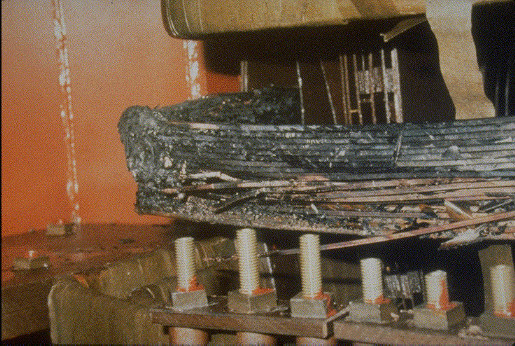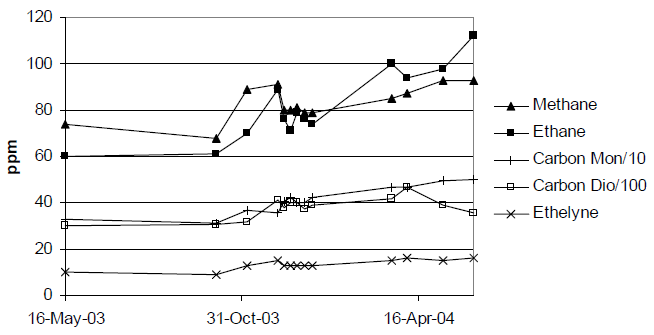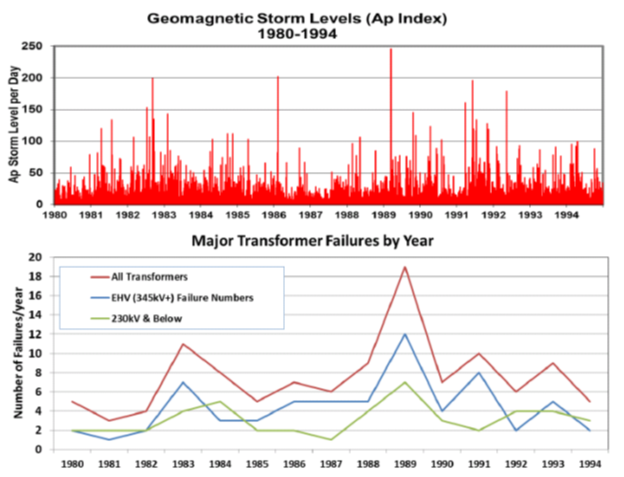This is the fourth post in a series about geomagnetic storms as a global catastrophic risk. A paper covering the material in this series was recently released.
I devoted the first three posts in this series to describing geomagnetic storms and assessing the odds that a Big One is coming. I concluded that the iconic Carrington superstorm of 1859 was neither as intense nor as overdue for an encore as some prominent analysts have suggested. (I suppose that’s unsurprising: those who say more-alarming things get more attention.) But my analysis is not certain. To paraphrase Churchill, the sun is a riddle, wrapped in a mystery, inside a corona. And great harm would flow from what I cannot rule out: a blackout spanning states and lasting months.
I shift in this post from whether the Big One is coming to what will happen if it does. And here, unfortunately, my facility with statistics does less good, for the top questions are now about power engineering: how grids and high-voltage transformers respond to planetary magnetic concussions.
One reason for my incomplete understanding of power engineering is that the stuff is complicated. Another is the upshot of this post: I dug far enough to conclude that more research is needed. That phrase is a dead cliche, but I mean it. We need to learn more! Considering the potential stakes, the effects of magnetic storms on grids are too poorly studied. Seven-figure expenditures on research might stave off 12-figure damages (as in trillions). For an employee of a philanthropy, that’s a bottom line. And the practical conclusion being reached, and my time being tight, it seemed efficient to stop there.
I’ll explain that conclusion just below. But first I stress that my view on the potential value of funding in this area is attributable only to me. The Open Philanthropy Project will weigh this cause against other possible focus areas.
I’ll touch on four lines of evidence:
- Case studies of failed transformers
- Statistical correlations between storm activity and transformer failures
- Field tests of transformers to simulate geomagnetic stress
- Mathematical modeling of power systems
Power lines and transformers are easier to fathom than the objects of the previous posts—sun spots the size of the earth and coronal clouds hurtling through space at 1% of the speed of light—but their behavior during storms is not necessarily better understood. One challenge for science is that to test a high-voltage transformer under realistic conditions, you need to channel enough power through it to serve a small city, and that is hard if you don’t have a spare small city on hand. Another challenge is that transformers are diverse in design, materials, age, quality of manufacture, and operating conditions, all of which impedes generalization. And transformers are, rather literally, black boxes: it’s hard to monitor what’s happening inside of them. Still another obstacle is that utilities and transformer manufactures probably know more than they say about the nature and consequences of the geomagnetic currents flowing through their systems.
In what follows, I’ll try to give a sense of what is known.
Case studies of failed transformers
The research literature contains scattered reports of failures of high-voltage transformers, including from New Zealand, South Africa, Sweden, the UK, and the US.[1] It turns out that many of these cases violate an image central to the doomsday scenario, of currents of once-a-century proportions spiralling into transformers and frying them within minutes.
The 1989 storm, for example, disabled two transformers in Québec and several at the Salem nuclear plant in New Jersey. Yet the currents that undid the Québec transformers were not generated by the storm but rather by hydroelectric dams to which the transformers were linked. As the Québec grid went through a disorderly, 72-second collapse, these transformers were momentarily forced to receive energetic load from the dams while being cut off from the grid to which they normally conveyed the energy. The recorded cause of death was “overvoltage.” As no other transformers appear to have been disabled, these two were casualties of the grid’s largely successful self-protective response.
In Salem, NJ, it appears that storm-driven currents indeed disabled the transformers there in the way envisaged in the doomsday scenario. Here are charred and broken coils found in one of them:
But the Salem plant’s experience is nonrepresentative in that the plant’s location put it at unusually high risk. Situated on an artificial island in the Delaware Bay, the plant complex served as an attractive electrical bridge between the regional power network to the west and the conductive Atlantic Ocean to the east. And the igneous ground beneath the plant is electrically resistive, so it could not absorb much of the intense electrical pressure. So, on the one hand, the Salem plant transformers look to have been more vulnerable than most. On the other hand, their story illustrates the danger of ignoring geomagnetic storms when designing power systems.
At the Salem plant, interestingly, the transformers died less with with a bang than a whimper: 10 days passed from shock to shutdown. That delayed response resonates with reports by Trevor Gaunt and Gert Coetzee from South Africa. The country had been seen as too close to the equator to be vulnerable to geomagnetic storms. Yet there, after the Halloween 2003 geomagnetic storm, the condition of eight transformers steadily degraded.[2] High-voltage transformers are bathed in oil for cooling. When magnetic cores saturate and the field strays outside the core (see my first post), wires and insulation can overheat and in effect burn. Hot spots manifest not as a flames (one hopes) but as chemical decomposition that forces gaseous byproducts into the oil, which can be monitored. In all of these eight transformers, degradation began right after storm activity and proceeded slowly, so that failure arrived in weeks or months rather than minutes. This graph shows parts per million of dissolved gases in one of the ill-fated transformers, at the Matimba power plant, over 12 months:
The gas concentrations began to creep upward after the Halloween storm. Perhaps during the storm, paper insulation around some of the wires was damaged, leading to short circuits and, in time, additional overheating. This suggests the existence of a perverse “goldilocks” magnitude for geomagnetically induced currents: weak enough not to trigger protective shutdowns, strong enough to disable a high-voltage transformer—in time.
The South Africa experience makes me wonder: perhaps the common focus on extremes (including in my own work) is partly misguided. Perhaps the greatest risk is posed by once-a-decade rather than once-a-century storms, or by lower-latitude exposure to those most extreme storms.
Statistical correlations between storm activity and transformer failures
The second line of evidence on transformer vulnerability is statistical. These graphs from a report by John Kappenman show that after peaks in storm activity, notably in 1982 and 1989, high-voltage transformer failures in the US spiked. The upper graph shows readings on the Ap storm intensity index, which is similar to the Dst index in my last post. The blue line in the lower graph shows the number of failures each year of the high-voltage transformers that are of greatest concern:
I have not managed to obtain the data for the lower graph, but the two graphs together make me reasonably confident that space weather is a major proximate cause of high-voltage transformer failure in the United States.
Field tests
Some engineers have experimentally run large currents through high-voltage transformers and measured the impacts. Typically these currents have been constant (direct current or DC, like what comes out of a battery or solar panel) rather than oscillating (like the alternating current or AC that is produced by most power plants and sent through most transformers). DC is an imperfect proxy for geomagnetically induced currents, which tend to vary more slowly than standard AC, but are hardly constant.
In the early 1990s, no doubt inspired by the great 1989 storm, engineers for Tokyo Electric Power, Toshiba, Hitachi, and Mitsubishi ran heavy currents through scaled-down models of transformers. The largest model was of the type that theory and smaller-scale tests indicated was most vulnerable. When receiving 200 amperes of current (some 10,000 times what’s needed to arrest a human heart), this model’s temperature rose 110 degrees Celsius over 20–30 minutes, then stabilized. “The magnitude of this temperature rise corresponds to a fairly large [geomagnetically induced current] level, and since the frequency of occurrence of this level is low and the duration of the effect is short, the effects on transformers from the viewpoint of lifetime reduction are sufficiently small.”
In Finland, Matti Lahtinen and Jarmo Elovaara tested a new, full-scale model of transformer commissioned by the Finnish grid operator Finngrid. They too poured large direct currents into a transformer that was carrying no normal load. They too were reassured. “The field tests…show that tested transformers may tolerate very high dc currents for times typical to geomagnetic storms.”
And in Québec, four researchers comparably tested two production transformers and found comparable reassurance.
This is all, well, reassuring. The major caveat is that we cannot be certain what would have happened under more realistic conditions: if the test current had been volatile as in a real storm, if the transformers had also been carrying normal power loads, and had been, say, 30 years old instead of new.
Mathematical modeling
Engineers have also built computer models to simulate what happens inside a big transformer when a geomagnetic storm sends electric current into it. Leading proponents of this approach are Ramsis Girgis and Kiran Vedante of ABB, a company that through mergers and acquisitions has retroactively become the maker of most high-voltage transformers in the US.
Girgis and Vedante contend that geomagnetically induced currents would do no disabling harm to the “great majority” of transformers. Why? Storms affect transformers in two main ways. The first is distortion in the currents going in and out. Normal currents are composed of smooth AC waves oscillating at 50 or 60 times per second. In a storm, the waveforms might gain noise, or wobble in frequency. The energy involved might not be overwhelming, but any such distortions can disrupt a finely tuned power system. Second, at particularly energetic moments, the storms can generate large current spikes that saturate the transformer’s magnetic core and cause overheating. The second effect, argue the ABB engineers, takes places over minutes, perhaps even hours, while the first is nearly instantaneous—and should trip protective equipment that will disconnect the transformer before the second does serious harm. If a large storm “trips” many transformers, a blackout may ensue. But in that fragility lies resilience: after the storm passes, the grid can be switched back on.
Yes, concede Girgis and Vedante, some transformers have failed. But they were of obsolete designs, or poorly made. Of the Salem units, they write, “These were old transformers that had an old winding lead design.” The South African transformers were “over-insulated which did not allow proper oil flow in these leads resulting in the overheating.”
Girgis and Vedante may be right that transformer destruction will be the exception during major geomagnetic storms. I hope so. In their defense, they’ve been right so far.
But should we rely upon the word of the ABB experts? Girgis and Vedante’s published “methodology” paper in fact provides almost no details on their methodology nor how it was validated against empirical data. Evidently the model is proprietary. In effect, the public is asked to trust the manufacturer’s reassurances about the reliability of its products. I don’t see a problem with that. Also, we should rely on GM’s assurances about its ignition switches and Takata’s about its airbags…
Forgive the sarcasm. My purpose is not to impugn anyone’s professionalism but to highlight the dangers of relying on manufacturers’ assurances when the stakes for human life are high. Confronting a risk this great with the seriousness it deserves calls for a more disinterested assessment.
Conclusion
These four lines of evidence combine to produce a strange state of knowledge. Theory and field tests reassure. Statistical correlations and evidence from specific cases such as in South Africa suggest that not all is well.
I draw three conclusions—or infer three hypotheses for further exploration. First, modest magnetic tempests may do more harm over months than massive blasts do over minutes. (Of course, the modest tempests and massive blasts can be the same storms, experienced at different latitudes.) This hypothesis reconciles the year-to-year correlations between geomagnetic disturbances and transformer failures with the apparent loss of only a handful of transformers during the 1989 storm, the biggest of the postwar era.
This idea has complex implications for the effects of magnetic superstorms. A really big storm might cause hundreds of transformers to fail—perhaps over the following year, perhaps predominately at middle latitudes. The resulting exhaustion of spares and manufacturing capacity could be a slow-motion train wreck. Or perhaps, as may have already happened without anyone noticing, the degradation will be so gradual as to create no humanitarian risk.
Second, another way to reconcile the evidence at hand may be to factor in aging. The transformers simulated in models are ideals. The brand-new transformers put to field tests approximate the ideals as well as can be achieved. Perhaps as transformers wear out they become more vulnerable to storms. If a major storm administers the coup de grâce to many at once, one might argue that the storm is not the primary cause of their demise. But that would give little solace to people freezing in the dark. Or, in a subtle variation on this idea, perhaps old transformers are vulnerable by virtue of design rather than aging, as Girgis and Vedante suggested for some cases. Then the question becomes whether the field tests are representative of the current fleet of transformers in operation.
My last conclusion is practical. The empirical questions relating to transformers and grids are easier to answer than most in the social sciences or, for that matter, in astrophysics, because experiments can be run. And with so little research done, we are probably shy of the point of diminishing returns. With money, much more could be learned about the vulnerability of transformers and grids. The same goes for mathematical modeling: with modest expenditure, models could be built in the public domain that would be subject to broad scientific scrutiny and empirical testing.
Such investment in empirical and theoretical research would be worthwhile, for it might lead us to confirm and curtail a major vulnerability of modern civilization.
Notes
[1] Girgis and Vedante succinctly lists these cases while arguing against geomagnetic storms as the cause. A more developed but gated version of their article is here.
[2] Moodley and Gaunt 2012 refines the story of one of them, suggesting to a link to 2001 activity as well.



